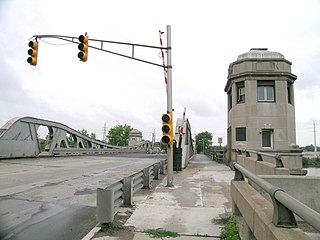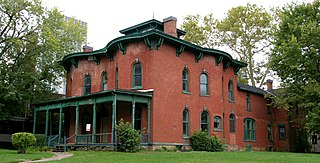
The Siegrist's Mill Covered Bridge is an 88-foot (27 m), Burr Arch Truss covered bridge over Chiques Creek between Rapho and West Hempfield townships, Lancaster County in U.S. state of Pennsylvania. Owned and maintained by the county, its official designation is the Big Chiques #6 Bridge.

The U.S. Grant Bridge is the name of the two bridges that carry and have carried traffic on U.S. Route 23 between Portsmouth, Ohio and South Portsmouth, Kentucky across the Ohio River in the United States. The original suspension bridge was closed and demolished in 2001 and the replacement cable-stayed bridge opened on October 16, 2006.

The Cornish–Windsor Covered Bridge is a 158-year-old, two-span, timber Town lattice-truss, interstate, covered bridge that crosses the Connecticut River between Cornish, New Hampshire, and Windsor, Vermont. Until 2008, when the Smolen–Gulf Bridge opened in Ohio, it had been the longest covered bridge in the United States.

Old Blenheim Bridge was a wooden covered bridge that spanned Schoharie Creek in North Blenheim, New York, United States. With an open span of 210 feet (64 m), it had the second longest span of any surviving single-span covered bridge in the world. The 1862 Bridgeport Covered Bridge in Nevada County, California, currently undergoing repairs due to 1986 flooding is longer overall at 233 feet (71 m) but is argued to have a 208 feet (63 m) clear span. The bridge, opened in 1855, was also one of the oldest of its type in the United States. It was destroyed by flooding resulting from Tropical Storm Irene in 2011. Rebuilding of the bridge commenced in 2017 and was completed in 2018.

The Cogan House Covered Bridge is a Burr arch truss covered bridge over Larrys Creek in Cogan House Township, Lycoming County, in the U.S. state of Pennsylvania. It was built in 1877 and is 94 feet 2 inches (28.7 m) long. The bridge was placed on the National Register of Historic Places in 1980 and underwent a major restoration in 1998. The Cogan House bridge is named for the township and village of Cogan House, and is also known by at least four other names: Buckhorn, Larrys Creek, Day's, and Plankenhorn.

The West Jefferson Avenue–Rouge River Bridge is a historic double-leaf bascule bridge in Wayne County, Michigan, at the border of the cities of Detroit and River Rouge. The bridge carries Jefferson Avenue, a major thoroughfare in Southwest Detroit, over the River Rouge, an important inland route for lake freighters. The bridge was built in 1922, and was listed on the National Register of Historic Places in 2000.

The Medora Covered Bridge was the longest covered bridge in the United states with the entire original historic truss still in place with some repairs but no structural changes. Measuring the clear span of 431 feet 10 inches (131.62 m), the Medora Covered Bridge is the longest historic covered bridge in the United States. The roof length of 461 feet (141 m) and the siding at the floor length of 459 feet (140 m) are also the longest historic covered bridge measurements in the U.S.

The McColly Covered Bridge is a historic wooden covered bridge in western Logan County, Ohio, United States. Located in Washington Township near the community of Bloom Center, it is one of two remaining covered bridges in Logan County. It carries County Road 13 over the Great Miami River, approximately 5 miles (8.0 km) south of its source at Indian Lake.

The Ashuelot Covered Bridge is a historic wooden covered bridge over the Ashuelot River on Bolton Road, just south of its intersection with NH 119 in Ashuelot, an unincorporated village of Winchester, New Hampshire. Built in 1864-65, it is one of the state's few surviving 19th-century covered bridges. It was listed on the National Register of Historic Places in 1981.

Berkeley Springs station is a historic railway depot located at Berkeley Springs, Morgan County, West Virginia. The depot is a one-story, rectangular red brick building with a bell-cast, red tile roof and measures approximately 80 feet long by 20 feet wide. It features Mission Revival style details.

The Seguin Covered Bridge, also called the Upper Covered Bridge and the Sequin Covered Bridge, is a wooden covered bridge that crosses Lewis Creek in Charlotte, Vermont on Roscoe Road. It was built about 1850, and is a distinctive variant of a Burr arch design. It was listed on the National Register of Historic Places in 1974.

Cozad–Bates House, also known as the Cozad–Bates House Interpretive Center, is the oldest and only surviving pre-Civil War structure in University Circle, Cleveland, Ohio, located at the Mayfield Road and East 115th Street intersection. It is historically known for its involvement in the Underground Railroad. Abolitionist Andrew Cozad built the house in 1853 for his son Justus L. Cozad, who in 1872 added an Italianate front to the structure. Architecturally, it is a rare surviving example of Italianate-influenced residential architecture in America at that time, which includes a hipped roof, curved bay windows, paired eave brackets, and prominent belvedere. The house was listed on the National Register of Historic Places in 1974 and designated as a Cleveland Landmark in 2006.

Everett S. Sherman (1831-1897) was a covered bridge builder in Ohio. He lived and built bridges in Delaware County then moved to Preble County after a storm destroyed many of its bridges.

The Stonelick Covered Bridge is located on Stonelick-Williams Corner Road in Clermont County, Ohio, crossing the Stonelick Creek. The one-lane covered bridge was built in 1878. It is 140 feet long and supported using a 12-panel Howe truss. The property was added to the National Register on September 10, 1974, being the last surviving covered bridge in Clermont County.

The Warnke Covered Bridge, also known as Warnke Bridge, is a historic covered bridge crossing Swamp Creek in Harrison Township, Preble County, Ohio, northeast of Lewisburg. Built from 1895 to 1896 by Everett S. Sherman, it has a span of 51 feet. It was listed on the National Register of Historic Places in 1976.

The Christman Covered Bridge is a historic covered bridge that carries Eaton-New Hope Road over Seven Mile Creek in Washington Township, Preble County, Ohio, United States, northwest of the city of Eaton. It was built in 1895 by Everett S. Sherman, who built at least 20 covered bridges in Preble County. It was listed on the National Register of Historic Places in 1976.

The Harshaville Covered Bridge is a historic covered bridge spanning the Cherry Fork Creek at Harshaville, Adams County, Ohio, United States. Built in 1855, it is a Burr truss bridge with a 110-foot span. It has sheet metal siding, a metal roof and stone abutments. It was listed on the National Register of Historic Places in 1976.

The Delhi Bridge, also known as the East Delhi Bridge, is a one-lane, wrought iron Pratt through truss bridge that carries East Delhi Road over the Huron River in Scio Township, Michigan. The bridge was completed on October 12, 1883 to replace a wooden span built in 1851. In 1917, the bridge was severely damaged by a tornado but was rebuilt. After it was closed to traffic in 2005 for being unsafe, the bridge was renovated and reopened in 2009. The bridge is listed on the National Register of Historic Places.

The Waterloo Covered Bridge carries Newmarket Road over the Warner River near the Waterloo Falls in Warner, New Hampshire. The Town lattice truss bridge was built in 1859–60, replacing an earlier span at the same location, and is one of New Hampshire's few surviving 19th-century covered bridges. The bridge was listed on the National Register of Historic Places in 1976, and included in the Waterloo Historic District in 2003.

The Lincoln Covered Bridge is a historic covered bridge, just south of U.S. Route 4 in West Woodstock, Vermont. Built in 1877, it is one of the only known examples of a wooden Pratt truss bridge in the United States. It was listed on the National Register of Historic Places in 1973.






















